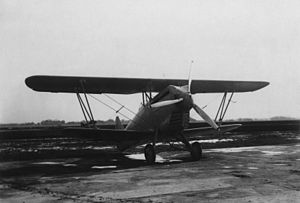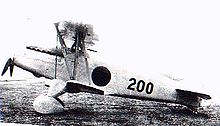avia.wikisort.org - Aeroplane
The Kawasaki Ki-10 (九五式戦闘機, Kyūgo-shiki sentōki, Army Type 95 Fighter) was the last biplane fighter used by the Imperial Japanese Army, entering service in 1935. Built by Kawasaki Kōkūki Kōgyō K.K. for the Imperial Japanese Army, it saw combat service in Manchukuo and in North China during the early stages of the Second Sino-Japanese War. Its reporting name given by the Allies was "Perry".
| Ki-10 | |
|---|---|
 | |
| Ki-10 Model 1 | |
| Role | Fighter |
| National origin | Japan |
| Manufacturer | Kawasaki Kōkūki Kōgyō K.K. |
| Designer | Takeo Doi |
| First flight | March 1935 |
| Introduction | 1935 |
| Retired | 1942 |
| Status | Retired |
| Primary user | Imperial Japanese Army Air Force |
| Number built | 588 |
Design and development

The Ki-10 was designed by Japanese aeronautical engineer Takeo Doi,[1] who had succeeded Richard Vogt as chief designer for Kawasaki. The design was in response to a requirement issued by the Imperial Japanese Army for a new fighter, and was the winner of a competition against Nakajima's Ki-11. Although the low-wing monoplane offered by Nakajima was more advanced, the Army preferred the more maneuverable biplane offered by Kawasaki. In order to overcome the speed disadvantage the Kawasaki team used a metal three-blade propeller in the third prototype, while flush-head rivets were used in an attempt to reduce drag.[2]
The Kawasaki design had sesquiplane (unequal-span) wings, braced by struts, and with upper-wing ailerons.[1] The structure was of all-metal construction, which was then fabric-covered. Armament consisted of two 7.7 mm (.303 in) Type 89 machine guns, synchronized to fire through the propeller. The initial production version was powered by a liquid-cooled 633 kW (850 hp) Kawasaki Ha9-IIa V-12.[citation needed]
Operations
The Ki-10 was deployed in Manchukuo (Manchuria) and in the initial campaigns of the Second Sino-Japanese War in northern China.[citation needed]
On September 21, 1937, Major Hiroshi Miwa, formerly hired as a military flight instructor for Marshall Chang's Fengtian army air corps and well known in the Chinese military aviation circles of the time, commanded a flight of 7 Ki-10 fighters of the 1st Daitai-16th Hiko Rentai, on an escort of 14 Mitsubishi Ki-2 bombers to attack the city of Taiyuan where they encountered Chinese air force V-65C Corsairs and Curtiss Hawk IIs, shooting down a few, but Major Miwa himself was shot down and fatally wounded by Captain Chan Kee-Wong,[3] commander of the 28th Pursuit Squadron of the 5th Pursuit Group flying a Curtiss Hawk.[4]
By the time of the Nomonhan Incident (Battles of Khalkhin Gol) in 1939, the Ki-10 had become largely obsolete, and was being superseded by the Nakajima Ki-27.[5]
At the beginning of the Pacific War, the Ki-10 was retired to training and secondary missions, but later returned to front-line service, performing short-range patrol and reconnaissance missions in Japan proper and China in January–February 1942.[citation needed]
Variants

data from Japanese Aircraft of the Pacific War[6]
- Ki-10 : Prototype for Imperial Japanese Army Air Force (4 built in early 1935).
- Ki-10-I (Army Fighter Type 95-I): Initial production version (300 built December 1935 - October 1937)
- Ki-10-II : Prototype of modified Mark I, increased in length (1 built May 1936)
- Ki-10-II (Army Fighter Type 95–2): Improved production version (280 built June 1937 - December 1938)
- Ki-10-I KAI : Prototype Ki-10-I with modifications to engine and radiator (1 built October 1936)
- Ki-10-II KAI : Prototype - Aerodynamic modification of Ki-10-II, now designated Ki-10-I-KAI, with 634 kW (850 hp) Kawasaki Ha9-IIb engine (2 built November 1937)
Total production: 588 units[6]
Operators
 Japan
Japan
- Imperial Japanese Army Air Force[6]
- 1st Rentai IJAAF
- 4th Rentai IJAAF
- 5th Rentai IJAAF
- 6th Rentai IJAAF
- 8th Rentai IJAAF
- 11th Rentai IJAAF
- 13th Rentai IJAAF
- 4th Sentai IJAAF
- 9th Sentai IJAAF
- 33rd Sentai IJAAF
- 59th Sentai IJAAF
- 64th Sentai IJAAF
- 77th Sentai IJAAF
- Akeno Fighter Training School
Specifications (Ki-10-II)
Data from Japanese Aircraft of the Pacific War[6]
General characteristics
- Crew: 1
- Length: 7.2 m (23 ft 7 in)
- Wingspan: 10.02 m (32 ft 10 in)
- Height: 3 m (9 ft 10 in)
- Wing area: 23 m2 (250 sq ft)
- Airfoil: NACA M-12[7]
- Empty weight: 1,360 kg (2,998 lb)
- Gross weight: 1,740 kg (3,836 lb)
- Powerplant: × Kawasaki Ha9-IIa V-12 liquid-cooled piston engine, 634 kW (850 hp)
- Propellers: 3-bladed fixed-pitch metal propeller
Performance
- Maximum speed: 400 km/h (250 mph, 220 kn) at 3,000 m (9,843 ft)
- Service ceiling: 11,500 m (37,700 ft)
- Rate of climb: 16.67 m/s (3,281 ft/min)
- Wing loading: 75.7 kg/m2 (15.5 lb/sq ft)
- Power/mass: 0.36 kW/kg (0.22 hp/lb)
Armament
- 2 × fixed, forward-firing 7.7 mm (.303 in) Type 89 machine guns
See also
Aircraft of comparable role, configuration, and era
- Arado Ar 68
- Avia B-534
- Blériot-SPAD S.510
- Fairey Fantôme
- Fiat CR.32
- Gloster Gauntlet
- Hawker Fury
- Heinkel He 51
References
- Notes
- Francillon 1979, p. 86.
- Francillon 1979, p. 87.
- 网易历史, 丘智贤 (2018-02-02). "广东队长太原击落日本驱逐之王三轮宽_手机网易网". NetEase. Retrieved 2020-11-21.
1937年9月21日,太原,击落日军著名飞行员三轮宽的我空军第二十八队队长陈其光 (照片) - 支那事变殊勋录刊登之日本陆军航空兵中佐三轮宽 (照片)。
- Gustavsson, Hakans. "Chinese biplane fighter aces - Chan Kee-Wong". Biplane Fighter Aces - China. Retrieved 2020-11-21.
Chan saw Miwa dive at him from above. Chan countered by pulling his nose up to face Miwa head-on. Anticipating that Miwa would need to pull out of his dive after they pass each other, Chan pulled into a tight chandelle. He was into his manoeuvre even before Miwa passed him head-on. As a result, Chan was able get turned around and was above and behind Miwa when he began to pull out of his dive... Chan shot up Miwa's Ki-10, sending it crashing into a field near Ta Meng.
- "Ki-27 Fighter".
- Francillon 1979, p. 89.
- Lednicer, David. "The Incomplete Guide to Airfoil Usage". m-selig.ae.illinois.edu. Retrieved 16 April 2019.
- Bibliography
- Francillon, René J. (1979). Japanese Aircraft of the Pacific War. London: Putnam & Company Ltd. ISBN 0-370-30251-6.
- Green, William; Gordon Swanborough (1990). The Complete Book of Fighters. London: Greenwich Editions. ISBN 0-86288-220-6.
- Mikesh, Robert C.; Shorzoe Abe (1990). Japanese Aircraft, 1910-1941. Annapolis, MD: Naval Institute Press. ISBN 1-55750-563-2.
External links
- Rickard, J (9 March 2010), Kawasaki Ki-10 'Perry'
- Kawasaki (Ki-10) Type 95 ‘Perry’ at surfcity.kund.dalnet.se
- Debut in the Chinese Sky, Fighter “Kawasaki” Ki-10 at j-aircraft.com
На других языках
[de] Kawasaki Ki-10
Die Kawasaki Ki-10 war ein japanisches Jagdflugzeug und entstand unter der Leitung von Takeo Doi. Sie war das erste rein japanische Muster von Kawasaki.- [en] Kawasaki Ki-10
[fr] Kawasaki Ki-10
Le Kawasaki Ki-10 est un chasseur japonais de l'entre-deux-guerres.[it] Kawasaki Ki-10
Il Kawasaki Ki-10 (川崎 キ10 Kawasaki ki jū ?), indicato anche Aereo da caccia Tipo 95 (九五式戦闘機 Kyūgo-shiki sentōki?) in base alle convenzioni allora vigenti, e inoltre identificato con il nome in codice alleato Perry[2] fu un aereo da caccia monomotore biplano sviluppato dall'azienda aeronautica giapponese Kawasaki Heavy Industries negli anni trenta.[ru] Kawasaki Ki-10
Kawasaki Ki-10 (яп. 川崎機10 Кавасаки Ки-дзю:) — истребитель-биплан, разработанный фирмой Kawasaki под руководством Такэо Дои. Полное обозначение — истребитель армейской авиации «Тип 95» (яп. 九五式戦闘機 Кю:го-сики Сэнто:ки). Первый полет прототипа состоялся в марте 1935 года, самолёт был принят на вооружение Императорской армии Японии в 1935 году. В ВВС СССР носил условное обозначение И-95, получил кодовое имя ВВС союзников Perry («Пэрри»).Другой контент может иметь иную лицензию. Перед использованием материалов сайта WikiSort.org внимательно изучите правила лицензирования конкретных элементов наполнения сайта.
WikiSort.org - проект по пересортировке и дополнению контента Википедии